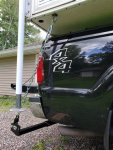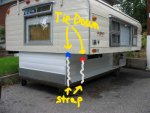Chorky
Observer
Since this seems the best location for this question...
In terms of general camper tie downs - they always seem to be outside the camper, going to usually the frame/bumper, possibly a truck bed, or maybe pocket die downs. Either way they always seem to connect to the outside corners of a camper. I'm no engineer but that seems to put a ton of unnecessary stress on a camper's frame. IF one had access to the inside of a truck bed (as if not using a full sized massive beast of a camper, but somethign like an Alaskan, or 4wh), wouldn't it be a better idea to tie down to the inside of the bed of a truck and the inside pocket corner of a camper? Assuming one had some sort of access hatch as otherwise you wouldn't be able to reach the turnbuckels. Even if spring loaded tie downs, this seems like it would put a lot less stress on bed/frame and camper especially for twisty frames.
Something like this (only not ratchets) which I think this is a Scout camper. Seems like it's a better method, again if you are able to reach into the bed. But maybe I am wrong in these assumptions?

In terms of general camper tie downs - they always seem to be outside the camper, going to usually the frame/bumper, possibly a truck bed, or maybe pocket die downs. Either way they always seem to connect to the outside corners of a camper. I'm no engineer but that seems to put a ton of unnecessary stress on a camper's frame. IF one had access to the inside of a truck bed (as if not using a full sized massive beast of a camper, but somethign like an Alaskan, or 4wh), wouldn't it be a better idea to tie down to the inside of the bed of a truck and the inside pocket corner of a camper? Assuming one had some sort of access hatch as otherwise you wouldn't be able to reach the turnbuckels. Even if spring loaded tie downs, this seems like it would put a lot less stress on bed/frame and camper especially for twisty frames.
Something like this (only not ratchets) which I think this is a Scout camper. Seems like it's a better method, again if you are able to reach into the bed. But maybe I am wrong in these assumptions?



